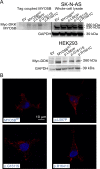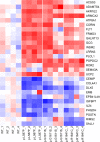MYO5B mutations in pheochromocytoma/paraganglioma promote cancer progression
- PMID: 32511227
- PMCID: PMC7329139
- DOI: 10.1371/journal.pgen.1008803
MYO5B mutations in pheochromocytoma/paraganglioma promote cancer progression
Abstract
Identification of additional cancer-associated genes and secondary mutations driving the metastatic progression in pheochromocytoma and paraganglioma (PPGL) is important for subtyping, and may provide optimization of therapeutic regimens. We recently reported novel recurrent nonsynonymous mutations in the MYO5B gene in metastatic PPGL. Here, we explored the functional impact of these MYO5B mutations, and analyzed MYO5B expression in primary PPGL tumor cases in relation to mutation status. Immunohistochemistry and mRNA expression analysis in 30 PPGL tumors revealed an increased MYO5B expression in metastatic compared to non-metastatic cases. In addition, subcellular localization of MYO5B protein was altered from cytoplasmic to membranous in some metastatic tumors, and the strongest and most abnormal expression pattern was observed in a paraganglioma harboring a somatic MYO5B:p.G1611S mutation. In addition to five previously discovered MYO5B mutations, the present study of 30 PPGL (8 previous and 22 new samples) also revealed two, and hence recurrent, mutations in the gene paralog MYO5A. The three MYO5B missense mutations with the highest prediction scores (p.L587P, p.G1611S and p.R1641C) were selected and functionally validated using site directed mutagenesis and stable transfection into human neuroblastoma cells (SK-N-AS) and embryonic kidney cells (HEK293). In vitro analysis showed a significant increased proliferation rate in all three MYO5B mutated clones. The two somatically derived mutations, p.L587P and p.G1611S, were also found to increase the migration rate. Expression analysis of MYO5B mutants compared to wild type clones, demonstrated a significant enrichment of genes involved in migration, proliferation, cell adhesion, glucose metabolism, and cellular homeostasis. Our study validates the functional role of novel MYO5B mutations in proliferation and migration, and suggest the MYO5-pathway to be involved in the malignant progression in some PPGL tumors.
Conflict of interest statement
The authors have declared that no competing interests exist.
Figures





References
-
- Kolackov K, Tupikowski K, Bednarek-Tupikowska G. Genetic aspects of pheochromocytoma. Adv Clin Exp Med. 2012;21(6):821–9. - PubMed
Publication types
MeSH terms
Substances
LinkOut - more resources
Full Text Sources
Medical
Research Materials

